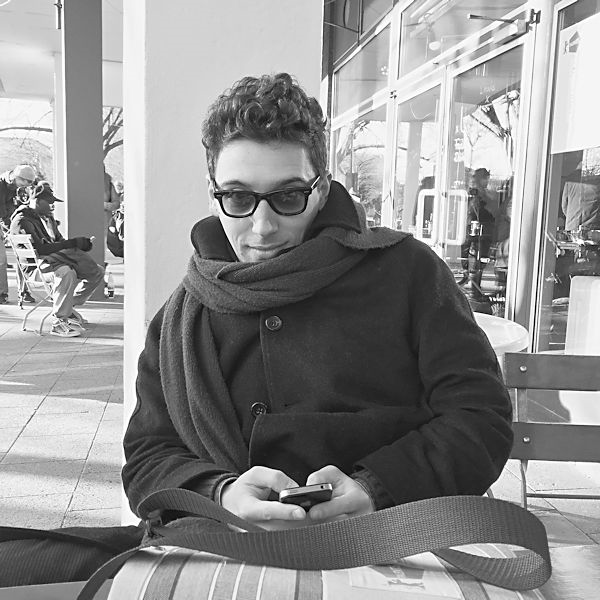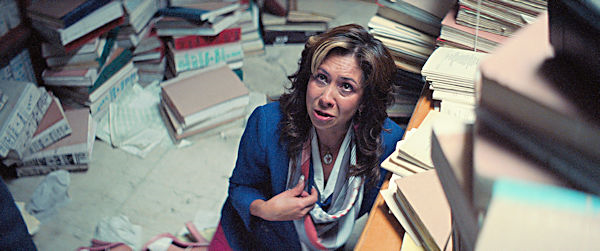First Day
Through the Eyes of a Compatriot, by Isabella Akinseye
On the Language of Trauma in Differing Cultural Contexts, by Liz Chege
Houses Without Doors: Insight from the Balcony, by Rasha Hosny
The Portuguese Take over the Berlinale, by Ruben Demasure
No One Here Gets Out Alive… nor Dead, by Sergio Huidobro
Of Shiny New Cars and Modern Society, by Tara Karajica
On Location, by Xin Zhou
Through the Eyes of a Compatriot
By Isabella Akinseye
The Berlinale Forum film “Panamerican Machinery” (Maquinaria Panamericana, Mexico/Poland) by Berlinale Talents alumnus Joaquín del Paso tells the story of the workers in a fairytale workplace where staff are treated like family until the sudden death of the owner. The film gives a dark and convoluted view on Mexican economy which differs from the optimistic treatments in the international media. This contradiction led me to interview my Mexican Talent Press colleague, Sergio Raúl Bárcenas Huidobro, to ascertain his view of this film from his home country.
“Yes, we have the problem of organized poverty and crime in Mexico,” Sergio acknowledges. “But in the film, the characters are caricatures. It ends up coming across as providing comedic relief which doesn’t work well. It seems like the filmmaker has an obvious need to prove his intelligence or abilities.”
Commenting on the film’s complicated sub-plots and stylistic elements, Sergio says, “Even for a Mexican viewer, “Panamerican Machinery” is not easy to understand. I think the filmmaker inserted them for dramatic interest but overall, it adds nothing to the plot.” I ask Sergio if he thinks the material will appeal to a wider Mexican audience. “This film won’t have any real distribution back home,” he replies. “It is more for the international audience and festival circuit who are comfortable seeing poverty and corruption in the Third World. Unfortunately, the average Mexican viewer is still okay with Spanish soap operas.”
As for his overall impression, Sergio concludes, “The film succeeds in showing the changes in Mexico’s socio-economic realities and raises serious questions about the positive trajectory being celebrated in the media. On the surface, Mexico is this company where everything works until the wool is pulled from our eyes. Now the question is do we brace up for the harsh truth or like the workers in the film, do we keep lying to ourselves and keep trying to salvage a dead situation?”
On the Language of Trauma in Differing Cultural Contexts
By Liz Chege
 After an epic journey to Berlinale 2016 consisting of three separate flights and an eight hour car journey, it was a privilege to speak to Hajooj Kuka who almost couldn’t make it to the festival this year either. I spoke to him about his film “Beats Of The Antonov” which screened last year at Berlinale and the theme of psychological trauma which was explored in the documentary. In particular, Kuka mentioned the expectations audiences had prior to watching his film and the actual experiences of the people displaced by war. In this interview excerpt, Kuka talks about the importance of context and language when discussing the theme of this year’s Berlinale Talents program, “The Nature of Relations”.
After an epic journey to Berlinale 2016 consisting of three separate flights and an eight hour car journey, it was a privilege to speak to Hajooj Kuka who almost couldn’t make it to the festival this year either. I spoke to him about his film “Beats Of The Antonov” which screened last year at Berlinale and the theme of psychological trauma which was explored in the documentary. In particular, Kuka mentioned the expectations audiences had prior to watching his film and the actual experiences of the people displaced by war. In this interview excerpt, Kuka talks about the importance of context and language when discussing the theme of this year’s Berlinale Talents program, “The Nature of Relations”.
I asked Kuka about how in his film, the people have been through traumatizing experiences due to the civil war in Sudan, and to tell me about his journey during the filming and what he witnessed in the context of mental health. His response was: “When you think ‘relations’ in this context [Germany], I feel like we’re looking at a Eurocentric perspective… When it comes to drama and mental health through my work, people who have seen my film look at the music and how people have been able to use their culture. And they start by talking about the mental health and how people there ‘must’ be traumatized. From time to time, an NGO would come through and see our work and say ‘oh this is good for drama healing and ask ‘how is this affecting the people? People are dancing and happy’ and I would say I don’t understand what you’re looking for but I don’t see it. Maybe later the trauma is going to show up because it’s deeper, but they kept saying the trauma is there and we just need to figure it out. For a time, I started to believe that and I began to look for it, but after a while, I realized this is a Eurocentric way of looking at it…this is a very different culture, a different war…I think one of the troubles we have with mental health is that the vocabulary we have right now is limited.”
Houses Without Doors: Insight from the Balcony
By Rasha Hosny
“Houses Without Doors” (Manazil Bela Abwab, Syria-Lebanon, 2016) by Avo Kapealian is a documentary in the Berlinale Forum about the refugees in Aleppo, a city that sheltered persecuted Armenians 100 years ago and now houses many displaced Syrians.
Kapealian made a comparison between the Armenians’ situation 100 years ago and the recent crisis of the Syrians, and the similarities are striking. Syrian and Armenian refugees were displaced and had to cross many borders searching for justice and safety for themselves and for their children.
The filmmaker shot his film with a small hand-held camera so most of the photography is out of focus and unstable. This helped in reflecting the rockiness of the situation. Throughout the film, Kapealian shot the daily routine of his neighborhood from his balcony, showing how war has affected people’s every day activities. On the other hand, some shots felt redundant and unnecessary as if the director kept repeating himself pointlessly.
The director’s mother stated in the film that children’s perspectives have changed completely since the war started. For example, they began viewing life as a matter of blood, bombs and war. Even their games became acts of war using their toys as weapons.
“Houses Without Doors” is an experimental documentary since Kapealian did not follow the traditional documentary form. Instead, he let the story be the driving force. The use of archival footage of the extermination of Armenians at the hands of Turkish soldiers mirrors the current situation of Syrian refugees. By doing so he shows us how history keeps repeating itself, and how Armenians are once again being displaced.
Despite AND because of the many challenges the filmmaker faced, the documentary ended up being a successful experiment on how to overcome difficulties in front of and behind the camera. Kapealian made this movie to capture the attention of the whole world. He wanted to say that something horrifying is happening in this place on earth.
The Portuguese Take over the Berlinale
By Ruben Demasure
 Berlinale Talent and Portuguese producer Pedro Fernandes Duarte has a cameo in his compatriot, Gabriel Abrantes’ film “Freud And Friends”. Screening in Berlinale Shorts, the film travels inside the brain of artists and filmmakers and documents their dreams. Similarly, Duarte tries to access the minds of the creative of his country for us and discusses why they are in the spotlight in record numbers at this year’s Berlinale. With four features and four shorts – one in the main competition, two competing shorts, and the others in Berlinale Forum – he says that it’s a sign of “a film scene achieving a certain maturity.”
Berlinale Talent and Portuguese producer Pedro Fernandes Duarte has a cameo in his compatriot, Gabriel Abrantes’ film “Freud And Friends”. Screening in Berlinale Shorts, the film travels inside the brain of artists and filmmakers and documents their dreams. Similarly, Duarte tries to access the minds of the creative of his country for us and discusses why they are in the spotlight in record numbers at this year’s Berlinale. With four features and four shorts – one in the main competition, two competing shorts, and the others in Berlinale Forum – he says that it’s a sign of “a film scene achieving a certain maturity.”
Duarte notes a paradox in this year’s Portuguese invasion. Of the eight that have films in the festival, most of them live abroad. Only Abrantes and Salomé Lamas, represented in the Forum with “Eldorado XXI”, currently reside in the country. Because of the crisis, almost half of the young population has emigrated, Duarte explains.
He and his partner, Joana Gusmão, are among the few young producers in the country. With Primeira Idade, they founded a new, independent production company. Previously, the twenty-nine year old was working for Rosa Filmes, producing work by his former film professors. Now he wants to make an impact by helping emerging filmmakers.
Another paradox Duarte highlights is although the Portuguese are present at prestigious festivals, the country’s film industry is disadvantaged by the fact that there’s almost no national funding. In November 2015, all budgets were frozen because of the financial crisis, but now, the Ministery of Culture is solving the problem because of the popularity of Portuguese films at the Berlinale.
An older generation of filmmakers was praised by prominent film critics but their films weren’t at international festivals. The major change Duarte sees is that the country now has professionals that know how festivals work. Until the 1990s, Portuguese producer Paolo Branco was the only exception. Being the European producer that has produced the most feature films, this living legend is present at the festival with Hugo Veira da Silva’s Forum film, “An Outpost Of Progress”. Duarte concludes that he wants to preserve the tradition with new and young voices.
No One Here Gets Out Alive… nor Dead
By Sergio Huidobro
One can say t hat young Mexican filmmaker Joaquin del Paso knows what a dark comedy is. There’s a brief scene in his debut feature “Panamerican Machinery” (Maquinaria Panamericana, Mexico, 2016) that proves that. In a murky one-company-building, a phone rings over and over again. A secretary transfers the call to her neighboring worker, without asking. Then three or four times again, from one desk to another, within the same shot. In the meanwhile, viewers laugh increasingly but then, a mournful weep as a result of the call makes a sudden silence over both the ringing and the laughing.
hat young Mexican filmmaker Joaquin del Paso knows what a dark comedy is. There’s a brief scene in his debut feature “Panamerican Machinery” (Maquinaria Panamericana, Mexico, 2016) that proves that. In a murky one-company-building, a phone rings over and over again. A secretary transfers the call to her neighboring worker, without asking. Then three or four times again, from one desk to another, within the same shot. In the meanwhile, viewers laugh increasingly but then, a mournful weep as a result of the call makes a sudden silence over both the ringing and the laughing.
Located inside a defunct machinery import business in Mexico City, the film describes a group of underpaid workers’ reaction upon finding their boss dead in his office. They descend into a kind of communist tribalism, hiding his corpse until they find some proof of hidden money in his accounting books, so they can save and own the business. Despite some sparks of brilliant visual humor like the one described, this dramatic comedy that premiered in the Berlinale Forum sometimes feels like one of the aged machines alluded to in the title.
Born in Mexico City and graduated from the prestigious Lodz Film School, del Paso fails when it comes to making a farce out of the dusty industrial environments or the lives wasted in it. The film has a healthy sense of irony, but if we read its plot as a metaphor of an economy broken by corruption, we hardly notice either if it’s motivated by social criticism or purly mocking. It takes advantage of its naïve non-professional cast (despite some fortunate casting choices) like a mediocre bureaucrat who turns into a kind of self-motivational populist leader.
It feels natural for the film to premiere in Berlin, as five of its crew members are Berlinale Talents alumni: del Paso, three producers and two members of the editing team. Unfortunately, the resulting film is an example of an outstanding idea getting an unfinished development or creative choices made out of lack of funding, despite an often good sense of mise-en-scene and sensitive timing when it comes to mixing drama and laughs.
Of Shiny New Cars and Modern Society
By Tara Karajica
 Based on the prize-winning semi-autobiographical novel of the same name by Kristian Lundberg, Berlinale Forum film “The Yard” (Sweden/Germany) follows a single father and struggling poet who suddenly loses his job as a literary critic after reviewing his own book. With no formal education and nothing to fall back on, he tries to maintain his position in lower middle class society as the sole provider for his young son. A temp agency ironically called “Dream Job” places him at Yarden, Malmö’s transshipment hub for import cars. In this cold and gloomy place where solidarity between workers no longer exists, he is renamed 11811, working among immigrants and under the strict regulations of the Swedish management. At home, the relationship with his teenage son quickly crumbles as their lifestyle begins to decline.
Based on the prize-winning semi-autobiographical novel of the same name by Kristian Lundberg, Berlinale Forum film “The Yard” (Sweden/Germany) follows a single father and struggling poet who suddenly loses his job as a literary critic after reviewing his own book. With no formal education and nothing to fall back on, he tries to maintain his position in lower middle class society as the sole provider for his young son. A temp agency ironically called “Dream Job” places him at Yarden, Malmö’s transshipment hub for import cars. In this cold and gloomy place where solidarity between workers no longer exists, he is renamed 11811, working among immigrants and under the strict regulations of the Swedish management. At home, the relationship with his teenage son quickly crumbles as their lifestyle begins to decline.
Celebrated Swedish cinematographer and director Måns Månsson is an unconventional social observer who defies the narrative conventions of cinema, brilliantly concocting a subtle political study of human loneliness and the structures of authority. He examines how people deal with the issues of integration and what drives the choices they make. Although the book was written in 2009, the film is thoroughly contemporary. The rise of immigration has created “us vs. them” social tensions, and Månsson perfectly conveys it here. His film gives a straightforward take on modern day Sweden, and his approach to the material is not at all sentimentally manipulative. He uses the yard as a mirror of modern society, a prison and labor camp but also the distribution center for the ultimate symbol of freedom: shiny new cars that reflect an ideal hardly anyone can afford. Moreover, he eschews background information on the protagonist or the reasons behind his earlier behavior, but in the current state of affairs, it is not difficult to relate to him.
Social commentary aside, “The Yard” is technically impeccable. Ita Zbroniec-Zajt’s grey lensing is evocative and reflective of the film’s subject and atmosphere. The choice of the operatic score is excellent and combined with Patrick Stromdahl’s sound design, gives the film more texture and intensity. As far as the key performance is concerned, theatre actor Andres Mossling is outstanding as 11811.
All in all, “The Yard” is a cinematic, soberly observant, powerful and provocative film that raises more questions than it gives answers to.
On Location
By Xin Zhou
 On May 4th, 1970, in response to Richard Nixon’s invasion of Cambodia, four students at the Kent State University were murdered during the massive student protest in the United States. Situated in the context of the anti-Vietnam War movement, Claudrena N. Harold and Kevin Jerome Everson studied in Forum Expanded’s “We Demand” one particular incident at the University of Virginia (UVA) where they both teach.
On May 4th, 1970, in response to Richard Nixon’s invasion of Cambodia, four students at the Kent State University were murdered during the massive student protest in the United States. Situated in the context of the anti-Vietnam War movement, Claudrena N. Harold and Kevin Jerome Everson studied in Forum Expanded’s “We Demand” one particular incident at the University of Virginia (UVA) where they both teach.
Mostly re-enacted by Harold and Everson’s colleagues and students at UVA, this 10-minute short docu-fiction was shot primarily from the perspective of James Roebuck. Just one month before the political outburst, Roebuck had been elected the first African American president of the student council at UVA and had mobilized the campus during the ten day revolt. This seminal experience turned out not to be an isolated chapter of his political activism but the blueprint of the politician to be.
While Harold provides a historian’s perspective towards this material, Everson’s contribution is more formalist. By choosing to re-enact and synchronize the scenes of the past in the present tense, the relationship between art and narrative becomes ambivalent. One scene features a conversation between Roebuck and Edgar Shannon, the then-current president of the UVA, who was upset about how the students were treated during the revolt. He delivered a letter that not only criticized Nixon but also the war and the politicians in the state of Virginia. The letter was fictionalized in the film as a conversation between the two characters in a road movie style.
During the post-screening discussion, the filmmakers related the surprise of the university community at the discovery of archival footage of the protest. Acts of civil disobedience were not typically documented by locals in the southern states. Such a revelation shows the impact of these filmmaker-activists who use their work to re-engage their community with the rediscovered materials of their political past.
